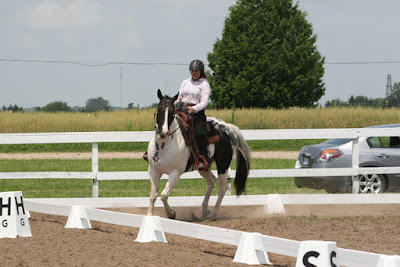 |
| An acceptable corner for walk. But too deep for the Lower Levels in Jog and Lope |
Riding corners properly for the level you are riding at, is simple if you follow some guidelines:
The basic rule of thumb is: Never ride a corner so deep that your horse loses it's balance.
A
corner at a level should have slightly the smaller diameter of the
largest circle that is in the particular level's test. If you are riding
Introductory and Basic Level, your corner should be between 10-12m in
angle diameter. It will be executed like riding a 1/4 circle in the
corner.
Avoid trying the 90 degree turn approach. The corners are ridden so that the horse does not lose balance and connection with
the rider. A horse is not shaped like a 90 degree turn, so it should
never be attempted that way.
 |
| Too sharp of a
turn will cause the horse to lose lateral balance. The horse's
shoulders have fallen to the outside and this horse is now over-bending.
The will greatly affect the quality of the next movement. | | |
|
|
|
At Level 1, I would like to see a 10m quarter circle
for the corner. When riding Level 2 and above, the ideal corner should
be 8m as we are now increased in collection and with improved balance,
it should be fairly easy for the horse to carry it's self through the
corner. Larger corners will show the avoidance to the lack of difficulty
and affect marks on both the actual test and the in the general
impression section of the test.
Regardless
of what you are riding or training at, familiarity to the ring size is
imperative. A little bit of math helps eliminate the intimidation the
Dressage Court. Whether you are riding in the 20X40m or 20X60m ring, the
corner letters are always 6 metres from the corner. Although the
placement of the dressage letters in the arena are a bit of a mystery,
the letters are placed 6 metres from the corners allows the average
correct striding though a corner in all 3 gaits. If the distance of the
corner markers were decreased, it makes the corner too tight and
therefore decreases the size of a corner. Remember that we have to take
in consideration the amount that a young horse can bend and balance
through a corner. To make the corners too tight is unfair and will
affect the rhythm of the horse. Even gaited horses who move in more of a
lateral type intermediate gait would have a tough time maintaining a
steady gait with a tight corner.
Even at the Intro and Basic
levels we have to make sure that there are at least a couple of straight
steps before the first letters to enable preparation for diagonal
lines. The short side of the arena is a straight line and not an oval.
The turn through the corner enables the horse to transition from a
straight short side, to a straight long side.
 |
| Adding a cone just to the inside of your track can help you develop a reference point for your corners. |
No matter the level, the corner is important. Think
about using them as the place to organize your horse before the next
exercise. Assessing balance, bend and ensuring engagement of the hind
quarters can help you prepare for the next movement.




